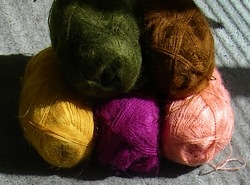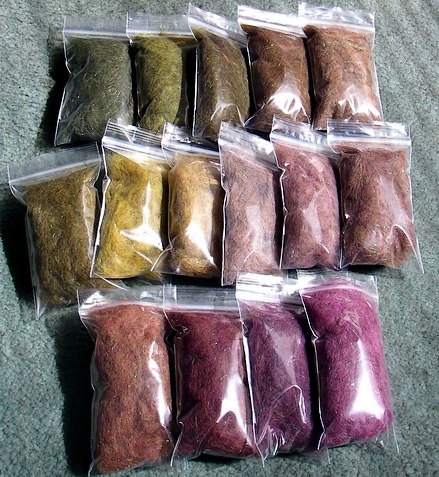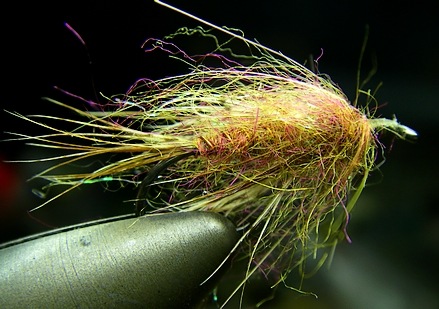You might say my day started poorly. I’m up extra early attempting to cram in a fast run to Sporting Creek even though it’s supposed to be chore day.
My first mistake was making the coffee using the dubbing grinder – the Obergruppenführer of Romance insisted I be doubly good in her absence and had outlined a long string of chores to accomplish. The commandment was “…and don’t mess or dirty anything!’” – and I’m spewing Angora French Roast out of my nose while hacking up a claret hairball.
I figured “dry grinding” some of the my double-extra complex dubbing could be done while fixing leaky faucets and doing the laundry. A once-over with a wet sponge and the countertop is “guy clean”.
… and if she spots a dust mote shrug shoulder and act innocent.
Now I’ve got French Roast dripping from the kitchen cabinets and using her pasta fork to scrape squirrel off my tongue. At 3AM you simply strain the coffee through a washcloth and keep packing the truck. Tastebuds don’t wake up till 4:00 AM – so the washcloth doesn’t even have to be clean …
 Fishing was frustrating and fun – but meeting my first female brownliner was a first. I was already in deep yogurt with the Missus, so I didn’t compound the sin by chatting longer than pleasantries.
Fishing was frustrating and fun – but meeting my first female brownliner was a first. I was already in deep yogurt with the Missus, so I didn’t compound the sin by chatting longer than pleasantries.
I manfully tied on an apron when I returned and did my best not to sulk.
“Dry dyeing” uses the colors of the components to make new colors. I started with 5 colors of an angora-mohair blend, 4 natural furs, and the Soft Crimp Angelina. While diligently mopping the kitchen, mowing, changing light bulbs, and doing all the rest of the honey-do’s, I’d periodically return to the scene of the crime and mash the grind button.

That’s a grapefruit sized ball of dubbing in each color, enough to tie many thousands of questionables. A little judicious use of the Artist’s Color Wheel allowed me to get a full spectrum of buggy colors with only the five yarn blends as coloring agent.
Most were constructed of equal parts of an adjacent color, some have three, others require four. Can you pick out the color that is all five mixed together? (*answer below)
Just harken back to elementary school watercolors – and what happened when they all ran together.

The above Birdsnest is constructed of brown partridge and a complex dubbing. It’s actually brown but photographed under a florescent (white light) lamp which lightens it up considerably. Note how the claret color stands out from the rest of the components.
Which is precisely what I expect on the Missus’s return. One white gloved swipe of the kitchen counter and she’ll mention, “ … note how the exhaled French Roast stands out from the faux walnut of my cabinets.”
How they do that is a mystery…
*Bottom left – the same color as used on the Birdsnest, note the difference of natural daylight versus florescent light in it’s appearance.
Tags: Angora, Mohair, blended dubbing, brownliner, partridge, artist’s color wheel, french roast, fly fishing, fly tying materials, deep yogurt, guy clean

Keith, are you still buying your angora mohair off e-bay?
Yes and no. The company now has a website where it can be purchased – but as they’re located in Turkey it’s best to buy large amounts … the postage is often as much as the yarn.
http://www.iceyarns.com/mohair-angora-yarns-for-winter_c4085.html
These are sold in 4 skein bundles for $7 per bundle + postage. It’s a lifetime supply. This particular yarn is my favorite as it tears apart with no visible threads remaining – wonderful stuff to work with.
So here’s a stupid question. Is Angora from a rabbit or a goat? I always thought it was goat, but apparently there are Angora Rabbits as well. I’m actually hoping rabbit, because anything that comes from a critter as silly looking as this is good in my book: http://www.alpacafarmgirl.com/wp-content/uploads/2009/08/angora_rabbit.jpg
Spencer
Have you nailed down a good sulply for this good stuf : Soft Crimp AngelinaSoft Crimp Angelina
@Spencer – If you compare the two the goat is longer, shinier, and a bit more wirey to the touch then rabbit. Both rabbits and goats get the Angora label, but it’s the rabbit version I prefer for this style of dubbing.
I call it “medium” dubbing. It can tie an #18 to a #6 – but works best in the medium sizes; 10, 12, 14. Each dubbing I make is tuned to the hook it will be used for – and medium is what I use for most trout-carp sizes.
@zac – alas, Soft Crimp Angelina is not sold anywhere. I may be forced to buy 10 pounds and sell it myself – stay tuned.
Buy 15 and let me kno when i comes in!
pure freaking genius. again. nice work beelzebub.